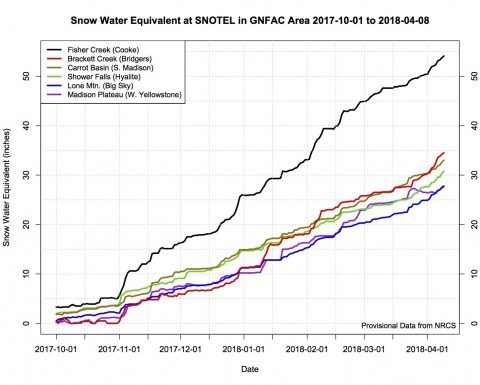
Friends of the Gallatin National Forest Avalanche Center claim that the winter of 2017-18 was one of the biggest of all time, and for the mountains around Cooke City, it was the biggest!
The GNFAC published their winter season summary yesterday recapping the highlights of this exceptional winter.

Below are the highlights (full document can be read here):
- Sept: Winter’s first major snowstorm impacted the region in mid-September, with multiple feet of snow. The mountains around Bozeman, Big Sky, West Yellowstone, and Cooke City picked up significant early season (September) snow. Longtime locals called it the best September skiing on record.
- Oct: Cold weather and moderate snowfall continued through early October, with close to a foot of snow falling in the first five days of the month. On October 7th, a local skier died in an avalanche on Imp Peak in the southern Madison Range, the earliest avalanche fatality since the GNFAC began in 1990.
- Nov: The last two weeks of October and most of November were fairly average for temperature and precipitation. The end of November saw above freezing temperatures and mountain rain across the advisory area.
- Dec: Winter returned in earnest by the middle of December with increased avalanche activity. The GNFAC issued its first avalanche warning on December 30th for the mountains around West Yellowstone and Cooke City. On January 2nd, the GNFAC saw its second avalanche fatality. A snowmobiler in the southern Madison Range near West Yellowstone remotely triggered a large slide and was buried three feet deep under his sled.
- Jan: Continued snow and wind during early January prompted the GNFAC to issue its second avalanche warning for the Lionhead area near West Yellowstone on January 10th. A snowmobiler was killed that day in the Centennial Range just south of West Yellowstone.
- Feb: The GNFAC put out three separate avalanche warnings for the mountains around Cooke City on February 5th, 8th, and 9th. On February 10th, a snowmobiler outside of Cooke City triggered and was buried in a large slide. Fortunately, he was quickly uncovered by his partners and unharmed. Starting February 10th the mountains experienced a four-day drought, the longest in two months.
- Mar: Winter returned for the last half of February and early March. By this time the snowpack had gained strength and avalanche activity was limited to storm snow and cornices. In early April both Big Sky and Bridger Bowl Ski Resorts reported base depths over 100”.
- Apr: On April 8th, the GNFAC issued its last daily advisory with a considerable danger on wind loaded slopes. The end of daily advisories was not the end of winter. Another significant storm April 11th through the 13th deposited over three feet of snow in the Bridger Range. Sadly, on April 14th, a skier was killed in an avalanche on Saddle Peak outside Bridger Bowl Ski Resort. The skier was traveling solo and buried for more than an hour. He was recovered by the Bridger Bowl Ski Patrol.
The GNFAC issued 153 daily advisories, the most ever issued during a single forecast season, and overall it was a safe and successful forecast season for the Gallatin National Forest Avalanche Center.